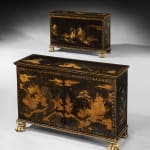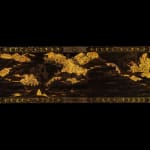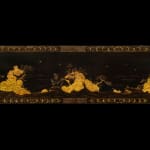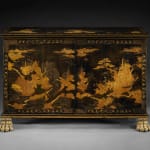Cabinets & Desks
A PAIR OF GEORGE III JAPANNED & LACQUERED SIDE CABIENTS
Depth: 16”. 40 cm
Height: 33” 84 cm
Further images
Provenance
Private Colletion, London
Private Collection, New York
Literature
Beevers, David. Chinese Whispers: Chinoiserie in Britain 1650–1930. Brighton: Royal Pavilion & Museums, 2008
Porter, David. The Chinese Taste in Eighteenth-Century England. Cambridge: Cambridge University Press, 2010.
Crossman, Carl L. Decorative Arts of the China Trade: Paintings, Furnishings and Exotic Curiosities on the High Seas. New York: Antique Collectors’ Club, 1991.
Jones, Yvonne. Japanned Papier-Mâché and Tinware c.1740–1940. Woodbridge: Antique Collectors’ Club, 2002.
Mengoni, Luisa E., and Francesca Leoni. Chinese Export Lacquer, 1550–1850. Oxford: Ashmolean Museum, 2010.
Murdoch, Tessa, and Michael Snodin. “The Painted Surface: Lacquer, Japanning and Vernis Martin.”
In The Arts of France from François Ier to Napoléon Ier: A Centennial Celebration of Wildenstein’s Presence in New York, edited by James D. Draper et al., New York: Metropolitan Museum of Art, 2005.
Watt, James C. Y., et al. East Asian Lacquer: The Florence and Herbert Irving Collection. New York: Metropolitan Museum of Art, 1991.
Forjaz, Jorge, and Maria Antónia Pinto de Matos. A Mirror of the Past: Chinese Export Lacquer Furniture in the Macao Museum Collection. Macao: Instituto Cultural de Macau, 2000.
A PAIR OF REGENCY BLACK AND GOLD CHINESE LACQUER AND ENGLISH JAPANNED SIDE CABINETS.
English, circa 1800
A pair of elegant and sophisticated Chinese lacquer and English Japanned side cabinets. The doors open to reveal two adjustable interior shelves, each cabinet is raised on brass paw feet.
These cabinets depict idyllic lakeside pavilions and garden vignettes, recalling the landscapes of classical Chinese painting. They must be understood within the broader cultural climate of the late eighteenth and early nineteenth century, when Britain had been trading with China for more than a century and importing porcelain, lacquerware, silk, and tea into elite households. Such goods were valued not only for their beauty but also for the exotic allure they conveyed, symbolising refinement, ancient civilisation, and distant sophistication.
The taste for Chinese-inspired decoration coincided with a growing interest in non-European philosophies. Figures such as Voltaire admired Confucian ethics, Adam Smith praised the stability of China’s imperial economy, and Jesuit missionaries returning from the Qing court described its order, ritual, and splendour. In the arts, this fascination found expression in chinoiserie, a European reimagining of China that blended authentic motifs with romantic imagination, and which allowed collectors to signal wealth, worldliness, and cultivated taste.
The Prince Regent’s transformation of Brighton Pavilion into a vision of Eastern splendour renewed enthusiasm for lacquerware, Chinese porcelain, and exotic motifs. In this context, the present cabinets exemplify the refined eclecticism of the Regency age, where classical structure met imported luxury and the allure of the imaginary East.
The cabinets embody the restrained elegance of classical English furniture design, with balanced proportions, clear architectural lines, and practical functionality. This disciplined framework provides the perfect compliment for the decoration, which depicts a world of imagined China, filled with idyllic pavilions, winding waters, and fantastical gardens. The juxtaposition of sober, measured form with such whimsical and almost mythical imagery captures the Regency taste for marrying refinement with imaginative escapism, making these cabinets both visually and culturally compelling.







